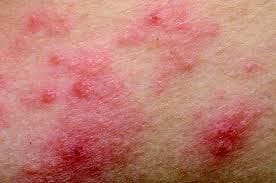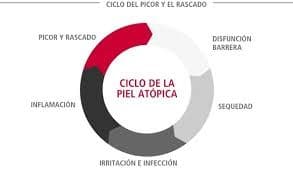Psoriasis
 It is an immunological inflammatory disease whose clinical expression attacks the skin. The immune system causes a very aggressive shedding leading to chronic skin inflammation.
It is an immunological inflammatory disease whose clinical expression attacks the skin. The immune system causes a very aggressive shedding leading to chronic skin inflammation.
It has been observed that the inflammatory stimulus generated increases the rhythm of cell division and keratinocytes and, as a result, the skin regenerates in 5 to 6 days instead of 1 month, which would be the normal time for healthy skin. The normal skin renewal process is modified and a pathological shedding is produced. The areas affected are clearly-defined and are usually very itchy.
 The study of some patients has allowed the detection of certain faults in several genes that might be responsible for this disease.
The study of some patients has allowed the detection of certain faults in several genes that might be responsible for this disease.
We must differentiate between three types of psoriasis: Psoriasis vulgaris, pustular psoriasis (raised bumps on the skin filled with pus) and psoriatic arthritis, which occurs simultaneously with joint inflammation. Different varieties of psoriasis may change throughout life, and more than one may appear at the same time. The early stage of the disease, which comes after the patient is 20 years old, seems to be more strongly linked to genetics than the advanced stage, which appears after the patient is 50 or 60 years old. The activity of this disease varies to a large extent and is usually produced in episodes.
Since psoriasis still has no cure, the main area of interest is the treatment of its symptoms. Together with a local treatment, usually with ointments, medicines are used against systemic effects, including those which perform in the immune system, phototherapy, laser treatments or special therapies in spas and rehabilitation centers.
Whole-body Cryotherapy has entered the therapeutic spectrum for psoriasis in the last years. It is nowadays part of what many cold therapy centers offer, and it is recommended by organizations and associations supporting psoriasis patients. Many different experiences show now positive results. A treatment cycle should last 4 to 6 weeks and includes 12 to 18 exposures to cold. The program for these cases will be medium or moderate. It is preferable to choose an inpatient treatment associated to a change in the environment instead of an outpatient therapy. It is important to eliminate extremely carefully the remains of topical use medicines such as ointments or creams before entering the cryosauna. The generally recommended treatment regimen consists of 3 sessions per week, alternating days, during 4 to 6 weeks. This will be retaken 4 to 5 times per year. These patients will take a Beginner program, less intense, in order to test their tolerance. Afterwards, they will take a medium-intensity program – Moderate is the most appropriate program in this case.
There are various experiences in relation with the effect that cold has when treating different types of psoriasis. Psoriasis vulgaris seems to be the type of psoriasis that presents a better response to cold stimulus, since the itching and the shedding intensity decrease after a few days. The good therapeutic results allow to obtain a significant regression of the disease and, in some cases, injuries are reduced to just non-itching skin redness. Whole-body Cryotherapy can also have therapeutic effects on the other two types to a lesser extent. It reduces inflammation in the affected joints.
It can be presumed that the therapeutic effect lasts a few months, and that it is convenient to take a cold therapy not only at the beginning of the episodes or when they are strong, but also as a prophylaxis when the symptoms are not especially strong.
In order to get good results, various factors that allow the symptoms of the disease to remain have to be taken into account. This is the reason why it is desirable to complete the treatment with a behavioral change: reducing the consumption of stimulants, controlling weight, correcting sleep patterns and getting psychological support to manage stress and using relaxation techniques. The psychological component in psoriasis is extremely important in order to succeed. Stress management disorders may aggravate the symptoms or be related to their activation, even after some time.
Integrity of the skin is particularly important when it comes to keep an appropriate social interaction, as the personal appearance is necessarily influential in our relationship with others. The observable pathological conditions of the skin affect self-confidence and self-esteem, and can have a negative impact on social acceptance, which might imply isolation. New clinically important health disorders might then be developed. This is why it is recommended to analyze behavioral problems before or during Whole-body Cryotherapy with a doctor or having the support of a psychologist if needed. The efforts to adjust the level of central activity and correct the modified sleep patterns may be effectively reinforced by using cold. It is also convenient to practice relaxation techniques regularly.
Atopic diseases
The term “atopy” defines this group of diseases as rare, and refers to a common immune mechanism and to the usually hereditary property of the organism to be hypersensitive to certain external stimuli. The result of this hypersensitivity is evidenced by diseases that can appear in different organs or tissues. That is the case of atopic dermatitis or eczema.
However, recent studies show that these diseases are not only a hyperreaction of the organism to the environment, but also that the genetic factors play a crucial role when it comes to its causes. This statement entails differences in the denomination of the diseases, so there are two different types:
● Endogenous disorders (intrinsic, non-allergic).
● Exogenous disorders (extrinsic, allergic).
Both types of atopic dermatitis carry skin inflammation. As it happens in psoriasis, the positive influence of Whole-body Cryotherapy on atopic dermatitis (skin inflammation and itching) was discovered by accident in patients who had gone through a cold therapy due to joint inflammation and who appreciated a significant improvement of their dermatitis.
Many people suffering from neurodermatitis come to cryotherapy centers to experience a relief of their difficult condition.
Atopic dermatitis / Neurodermatitis
 Many patients are dissatisfied with the treatment received to cure their disease. This is not due to a failure of the procedure, but to the fact that the studies carried in this area have not been able to develop causal therapeutic approaches yet. Also, in comparison with some medicines, the other therapies in use are not accepted by the patient, which is a prerequisite for a successful treatment. Furthermore, a single line of therapy is usually used, which means that diverse factors that encourage the disease are put aside. It is also important to take into consideration the fact that Whole-body Cryotherapy cannot fully replace other established treatments.
Many patients are dissatisfied with the treatment received to cure their disease. This is not due to a failure of the procedure, but to the fact that the studies carried in this area have not been able to develop causal therapeutic approaches yet. Also, in comparison with some medicines, the other therapies in use are not accepted by the patient, which is a prerequisite for a successful treatment. Furthermore, a single line of therapy is usually used, which means that diverse factors that encourage the disease are put aside. It is also important to take into consideration the fact that Whole-body Cryotherapy cannot fully replace other established treatments.
Up to 30 sessions of exposure to cold may be necessary depending on the severity of the clinical picture.
In this sense, the patient should remain hospitalized (in a clinic or a spa) when going through cryotherapy in order to eliminate the constraints, sometimes related to stress and other psychological factors that promote the disease. Topical medications, such as ointments or creams have to be removed before the cold session and reapplied afterwards. In general, any previous treatment should not be suddenly interrupted.
The itching tends to decrease during the first days of treatment, and so does the skin inflammation after around a week. In addition to the anti-inflammatory effect of cold, the analgesic effect is also important regarding the itching. It is believed that nerve stimuli resulting from itching are driven to the spinal cord by the same afferent channels than the painful stimulus. It can therefore be presumed that the alleviation of itching through a brief exposure to extreme cold is produced by the same mechanism as pain relief. The afferent Aδ nerve fibres are responsible for the transmission of cold and their conduction velocity is higher than C fibres’, which are responsible for itching signals. The fast conducting fibres inhibit the slow ones. An excitation competition is then established in the ascending nerve pathways. The consequence is the inhibition of itching by desensitizing and even deactivating itching receptors. The capacity of detecting these stimuli is therefore reduced.
It is recommended to go through a behavioral therapy along with cryotherapy. Relaxation techniques, stress management, reduction of social fears or improvement of self-control to avoid scratching could be used. Parents whose children suffer from neurodermatitis are encouraged to implement a probiotic therapy in order to restore their intestinal flora, which can regulate the damaged immune functions. This therapy should be taken before Whole-body Cryotherapy.





